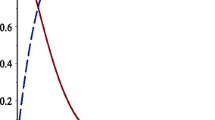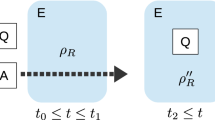Abstract
We investigate the decoherence control coupled to a rather general environment, i.e., without using the Markov approximation. Markovian errors generally require high-energy excitations (of the reservoir) and tend to destroy the scalability of the adiabatic quantum computation. Especially, we find that deriving optimal control using the Pontryagin maximum principle, the decoherence can be suppressed even in high-temperature reservoirs. The influences of Ohmic reservoir with Lorentz-Drude regularization are numerically studied in a two-level system under ω c ≪ ω 0 condition, here ω 0 is the characteristic frequency of the quantum system of interest, and ω c the cut-off frequency of Ohmic reservoir. It implies that designing some engineered reservoirs with the controlled coupling and state of the environment can slow down the decoherence rate and delay the decoherence time. Moreover, we compared the non-Markovian optimal decoherence control with the Markovian one and find that with non-Markovian the engineered artificial reservoirs are better than the Markovian approximate in controlling the decoherence of open, dissipative quantum systems.
Similar content being viewed by others
Explore related subjects
Discover the latest articles and news from researchers in related subjects, suggested using machine learning.References
Breuer H P, Petruccione F. The Theory of Open Quantum Systems. Oxford: Oxford University Press, 2002
Zhang J, Li C W, Wu R B, et al. Maximal suppression of decoherence in Markovian quantum systems. Journal of Physics A: Mathematical and General, 2005, 38(6587): 6587–6601
Lloyd S, Slotine J J E. Analog quantum error correction. Physical Review Letters, 1998, 80(18): 4088–4091
Zanardi P, Rasetti M. Noiseless quantum codes. Physical Review Letters, 1997, 70(17): 3306–3309
Chuang I L, Yamamoto Y. Simple quantum computer. Physical Review A, 1995, 52(5): 3489–3496
Alicki R, Horodecki M, Horodecki R, et al. Dynamical description of quantum computing: Generic nonlocality of quantum noise. Physical Review A, 2002, 65(6): 062101–062111
Zanardi P. Stabilizing quantum information. Physical Review A, 2001, 63(1): 012301–012304
Neumann J Von. Mathematical Foundations of Quantum Mechanics. Princeton: Princeton University Press, 1955
Nielsen M A, Chuang I L. Quantum Computation and Quantum Information. Cambridge: Cambridge University Press, 2000
Mensky M B. Quantum Menseurements and Decoherence: Models and Phenomenology. Dordrecht: Kluwer Academic Publishers, 2000
Shor P W. Scheme for reducing decoherence in quantum computer memory. Physical Review A, 1995, 52(4): R2493–R2496
Viola L, Lloyd S. Dynamical suppression of decoherence in two-state quantum systems. Physical Review A, 1998, 58(4): 2733–2744
Elattari B, Gurvitz S A. Effect of measurement on the decay rate of a quantum system. Physical Review Letters, 2000, 84(10): 2047–2051
Altafini C. Controllability properties for finite dimensional quantum Markovian master equations. Journal of Mathematical Physics, 2003, 44: 2357–2372
Rabitz H, ViVie-Riedle R, Motzkus M, et al. Whither the future of controlling quantum phenomena? Science, 2000, 288(5467): 824–828
Levis R J, Menkir G M, Rabitz H. Engineering Carbon Nanotubes and Nanotube Circuits Using Electrical Breakdown. Science, 2001, 292(5517): 706–709
Rabitz H. Shaped laser pulses as reagents. Science, 2003, 299(5606): 525–527
Krotov V F. Global Methods in Optimal Control Theory. New York: Marcel Dekker INC, 1996
Jirari H, PÖtz W. Quantum optimal control theory and dynamic coupling in the spin-boson model. Physical Review A, 2006, 74: 022306–022324
Sugny D, Kontz C, Jauslin H R. Time-optimal control of a two-level dissipative quantum system. Physical Review A, 2007, 76: 023419–023430
Weiss U. Quantum Dissipative System. Singapore: World Scientific Publishing, 1993
Gardiner C W, Zoller P. Quantum Noise (2nd Edition). New York: Springer-Verlag, 2000
Zurek W H. Decoherence, einselection, and the quantum origins of the classical. Review of Modern Physics, 2003, 75(3): 715–775
Garraway B M. Nonperturbative decay of an atomic system in a cavity. Physical Review A, 1997, 55(3): 2290–2303
Zhang J, Wu R B, Li C W, et al. Asymptotically noise decoupling for Markovian open quantum systems. Physical Review A, 2007, 75: 22324–022335
Tiersch M, Schützhold R. Non-Markovian decoherence in the adiabatic quantum search algorithm. Physical Review A, 2007, 75: 062313–062318
Blum K. Density Matrix Theory and Applications. New York: Plenum Press, 1981
Thorwart M, Hartmann L, Goychuk I, et al. Controlling decoherence of a two-level-atom in a lossy cavity. Journal of Modern Optics, 2000, 47: 2905–2917
Scully M O, Zubairy M S. Quantum Optics. Cambridge: Cambridge University Press, 1997
Meystre P. Atom Optics. New York: Springer-Verlag, 2001
Anastopoulos C, Hu B L. Two-level atom-field interaction: Exact master equations for non-Markovian dynamics, decoherence, and relaxation. Physical Review A, 2000, 62(3): 033821–033834
Shresta S, Anastopoulos C, Dragulescu A, et al. Non-Markovian qubit dynamics in a thermal field bath: Relaxation, decoherence, and entanglement. Physical Review A, 2005, 71: 022109–022119
Maniscalco S, Olivares S, Paris M G A. Entanglement oscillations in non-Markovian quantum channels. Physical Review A, 2007, 75: 062119–062124
Maniscalco S, Piilo J, Petruccione F, et al. Lindblad-and non-Lindblad-type dynamics of a quantum Brownian particle. Physical Review A, 2004, 70: 032113–032126
Myatt C J, King B E, Turchette Q A, et al. Decoherence of quantum superpositions through coupling to engineered reservoirs. Nature(London), 2000, 403: 267–273
Turchette Q A, Myatt C J, King B E, et al. Decoherence and decay of motional quantum states of a trapped atom coupled to engineered reservoirs. Physical Review A, 2000, 62: 053807–053829
Author information
Authors and Affiliations
Corresponding author
Rights and permissions
About this article
Cite this article
Cui, W., Xi, Z. & Pan, Y. Decoherence control for high-temperature reservoirs. Front. Comput. Sci. China 2, 129–137 (2008). https://doi.org/10.1007/s11704-008-0015-x
Received:
Accepted:
Published:
Issue Date:
DOI: https://doi.org/10.1007/s11704-008-0015-x




